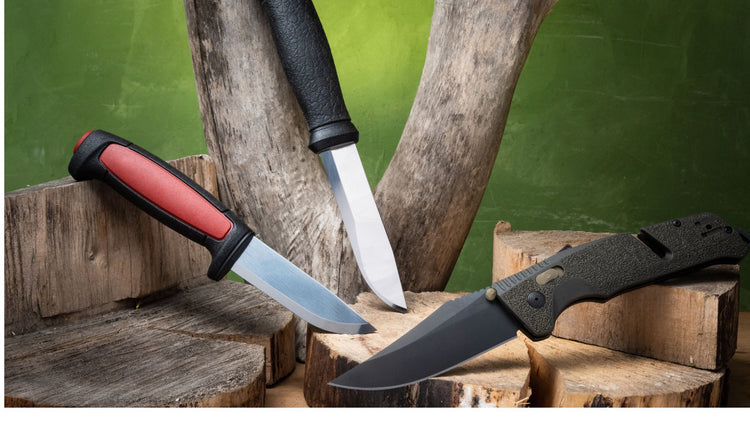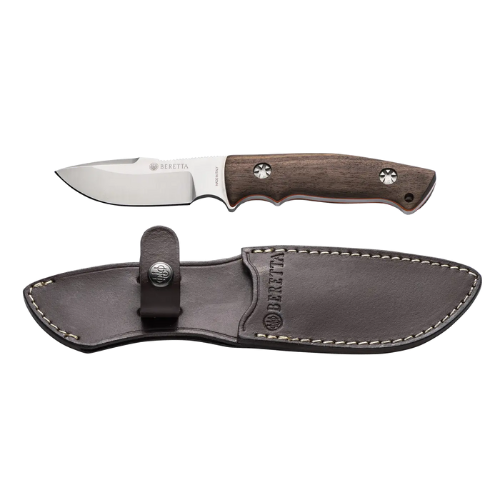The Right Hunting Knife: Types and Their Uses

A Guide to Choosing the Right Hunting Knife: Types and Their Uses
When it comes to hunting, having the right equipment is key, and one of the most essential tools for any hunter is a quality hunting knife. Whether you’re field dressing game, preparing meals in the wilderness, or tackling survival tasks, a reliable hunting knife can make a world of difference. However, not all hunting knives are created equal. Each knife is designed with specific tasks in mind, from skinning game to heavy-duty chopping. In this guide, we’ll break down the different types of hunting knives available and help you decide which one is best suited for your hunting adventures. Here we go through:
- Fixed Blade Knives
- Folding Knives
- Gut Hook Knives
- Skinning Knives
- Boning Knives
- Survival Knives
1. Fixed Blade Knives
Overview:
Fixed blade knives are the most common and versatile type of hunting knife. As the name suggests, the blade is fixed in place, offering a solid and robust tool. This type of knife is known for its strength, durability, and ease of use, making it ideal for heavy-duty tasks.
Best For:
- Field dressing large game
- Skinning
- Butchering and preparing meat
- General outdoor tasks like splitting wood
Popular Styles:
- Drop Point: The drop point is one of the most versatile knife designs. It has a thick, durable blade with a broad, curved edge, which makes it great for skinning and gutting animals without puncturing internal organs.
- Clip Point: A clip point knife has a thinner, sharper point, making it ideal for precision tasks like puncturing and slicing. It’s excellent for hunters who need detailed control.
2. Folding Knives
Overview:
Folding knives are compact, portable, and easy to carry, making them a popular choice for hunters who prefer a lightweight option. They come with a locking mechanism that keeps the blade in place when open, providing safety and functionality. While they aren’t as strong as fixed blades, they’re perfect for hunters who want a knife that can easily fit in their pocket or pack.
Best For:
- Small game hunting
- Light field dressing tasks
- Carrying in a compact EDC (Everyday Carry) setup
Popular Styles:
- Lockback Folding Knife: The lockback design features a strong locking mechanism, providing extra safety when the blade is open. This makes it a reliable choice for a folding knife that can handle moderate tasks.
- Liner Lock Folding Knife: Liner locks are easier to open one-handed, offering convenience when you need to quickly access your blade. These are great for multitasking hunters who need to switch between tools seamlessly.
3. Gut Hook Knives
Overview:
Gut hook knives feature a specialized hook-shaped blade that is designed specifically for field dressing game. The hook allows hunters to make clean, precise cuts along the belly of an animal without damaging internal organs, which is crucial for keeping meat uncontaminated.
Best For:
- Field dressing large game such as deer, elk, or boar
- Hunters looking for a knife tailored to skinning and gutting
Why Choose a Gut Hook Knife?
If you hunt larger animals frequently, a gut hook knife can significantly speed up the field dressing process. Many fixed blade knives come with a gut hook on the spine, offering the best of both worlds.
4. Skinning Knives
Overview:
Skinning knives are specifically designed for one primary purpose: skinning animals. These knives feature thin, curved blades that allow for precise control and smooth, sweeping cuts. A good skinning knife will ensure minimal damage to the hide, making it ideal for hunters who want to preserve the animal's fur or skin for taxidermy or crafting.
Best For:
- Skinning small or large game
- Precise, clean cuts when separating skin from meat
Popular Styles:
- Traditional Skinner Knife: This knife has a deeply curved blade with a razor-sharp edge, ideal for the back-and-forth motion of skinning.
- Ulu Knife: Although traditionally an Inuit tool, the Ulu knife has found its place in the hunting community due to its exceptional efficiency in skinning large animals. It features a half-moon-shaped blade that allows for a rocking motion, making skinning faster and easier.
5. Boning Knives
Overview:
Boning knives are a must-have for hunters who like to process their game in the field. With a long, thin, and flexible blade, these knives are designed to separate meat from bone with precision. They are particularly useful for hunters who want to butcher their own meat without needing to bring the game back to a butcher.
Best For:
- Deboning and butchering game
- Processing fish and smaller animals
Features to Look For:
- Flexibility: A flexible boning knife allows for better maneuverability around bones and joints.
- Sharp, narrow blade: A thin blade helps you make clean cuts, minimizing waste.
6. Survival Knives
Overview:
A survival knife is not strictly a hunting knife, but it’s a vital tool for any hunter who spends extended periods in the wilderness. These knives are designed to be multifunctional, capable of performing various tasks, from chopping wood to starting a fire.
Best For:
- Hunters who venture deep into the wilderness
- Survival situations where you need a versatile, heavy-duty tool
Popular Styles:
- Bushcraft Knife: Known for its durability and ability to perform a variety of outdoor tasks, from batoning wood to carving traps.
- Tactical Knife: Often used by military personnel, tactical knives are designed for combat but also serve as highly effective tools in survival and hunting situations.
Choosing the Right Knife for Your Hunt
Selecting the perfect hunting knife depends on several factors:
- The type of game you hunt: Larger game may require a sturdy fixed blade knife with a gut hook, while smaller game can be handled with a folding knife or skinning knife.
- Your experience level: If you're a seasoned hunter, you might prefer a specific knife for each task. However, if you’re new to hunting, a versatile drop point fixed blade or a folding knife might be a better choice.
- Durability and materials: Look for high-quality steel (such as stainless or carbon steel) and a comfortable, non-slip handle for maximum performance and safety.
Final Thoughts
Every hunter’s needs are unique, and no single knife will be perfect for all tasks. A serious hunter may carry multiple knives or choose a versatile tool that can handle a range of activities. Whether you’re skinning, gutting, or preparing food, investing in a high-quality hunting knife is essential for a successful and enjoyable hunting experience. At Wildhunter, we offer a wide selection of premium hunting knives to suit every need. Stop by today and find the perfect blade for your next outdoor adventure!










